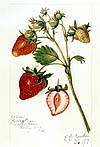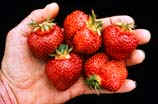Back
A Lesson in Strawberry History
 Strawberries are
indiginous to both the nothern and southern hemispheres. They have been found
growing by the seaside, in the woods, and on mountain tops. The strawberry was
first described in literature as early as 1000AD and the first sketch of a
strawberry plant was printed in 1484. The first mention of strawberries occured
sometime between 234-149 BC in the writings of Cato, a Roman Senator. The first
descriptions published were mostly for the medicinal uses of the plant and not
for the benefits of the fruit. For a period of time in the 12th Century Saint
Hildegard von Binger, then an abbess, pronounced that strawberries were unfit to
eat due to the fact that they grew close to the ground; it was thought that the
fruit was contaminated by the snakes and toads that may have touched them. This,
along with the support of her theory by local political figures, caused many
people to avoid the fruit and decreased its growing popularity. Charles
Linnaeus, however, put this superstition to rest by prescribing for himself a
diet of only the fruit.
Strawberries are
indiginous to both the nothern and southern hemispheres. They have been found
growing by the seaside, in the woods, and on mountain tops. The strawberry was
first described in literature as early as 1000AD and the first sketch of a
strawberry plant was printed in 1484. The first mention of strawberries occured
sometime between 234-149 BC in the writings of Cato, a Roman Senator. The first
descriptions published were mostly for the medicinal uses of the plant and not
for the benefits of the fruit. For a period of time in the 12th Century Saint
Hildegard von Binger, then an abbess, pronounced that strawberries were unfit to
eat due to the fact that they grew close to the ground; it was thought that the
fruit was contaminated by the snakes and toads that may have touched them. This,
along with the support of her theory by local political figures, caused many
people to avoid the fruit and decreased its growing popularity. Charles
Linnaeus, however, put this superstition to rest by prescribing for himself a
diet of only the fruit.
Strawberries began to be sold at a London marketplace around 1831. They were most likely harvested from nearby fields or woodlands and not from "commercial" production areas. In England and mainland Europe as the consumption of strawberries became more popular, many commoners as well as aristocrats would have a patch in their home gardens. France, though, became the the front runner in strawberry production.
The word Strawberry is in itself, peculiar to the English language. The name has a variety of posssible origins. Straw was commonly used to mulch the plants during the winter and as weed and soil control to keep the berries cleaner. In London children used to collect the berries, string them on pieces of straw, then sell them at the markets as "Straws of Berries". The runners which the plants produce are said to be strewn or dispersed around the plant. In some literature the fruit is called strewberry. In Latin the fruit is referred to as "Fragra" or Fragrant. Charles Linneaus gave strawberry the species name of Fragaria. In French, Italian, and Spanish the fruit is refered to as a "Fraise" or fragrant berry.The Narragansett Indians of North America called the fruit "wuttahimneash" or "heart berry".
The explorer Cartier brought strawberries back to France from his first trip to the Quebec Province of Canada in 1534 while another explorer, Hariot, brought plant specemins with him from Virginia to London. Other strawberry plants were brought to Europe from Chile and Peru where they had been cultivated and marketed long before the Spanish arrived. The strawberry plants found native in North America, were superior to all European varieties in size, flavor, and beauty. Only in 1697 were the first detailed accounts of strawberry production for larger fruit, including correct soil conditions, pest problems etc. written by the gardener at Versailles. In the 18th Century one of the first breeding crosses was made to improve the strawberry. A Virginia variety with good flavor and fruitfulness was crossed with a Chilean variety which lent the resultant offspring both size and firmness. This variety became known as the Pineapple or Pine strawberry due to its distinctive flavor.

"Hudson" was the first strawberry hybrid developed
in the USA in 1780. And in 1843 Cinncinatti Ohio growers were the first to ship
strawberries using refridgeration, in the form of ice placed on top of the
boxes. This development led to increase marketing areas and yet more increase in
popularity. For more information on the newest USDA strawberry releases please
see
Dr. Lewer's web site!
***Information for this lesson was gathered from "A History of the Strawberry, from Ancient Gardens to Modern Markets" by S. Wilhelm and J. Sagen, 1974 Univ. of Calif. Berkley.***
Ed, Debbie, and Nellie Bell
16447 State Road 38 -
Hagerstown, IN 47346
765-489-5753
765-489-6136 Fax
TT Relay 711
<><